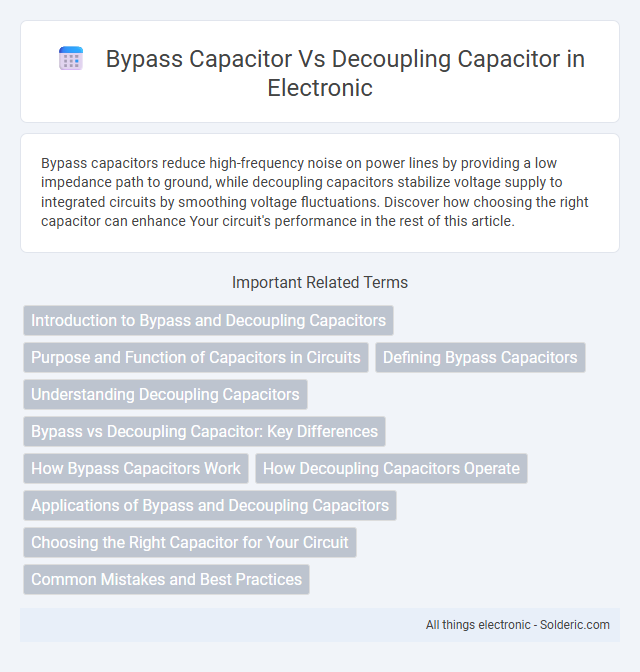Bypass capacitors reduce high-frequency noise on power lines by providing a low impedance path to ground, while decoupling capacitors stabilize voltage supply to integrated circuits by smoothing voltage fluctuations. Discover how choosing the right capacitor can enhance Your circuit's performance in the rest of this article.
Comparison Table
| Feature | Bypass Capacitor | Decoupling Capacitor |
|---|---|---|
| Primary Function | Shunts high-frequency noise from power lines to ground | Stabilizes voltage supply by isolating components from noise |
| Placement | Near power pins of active devices | Close to ICs or sensitive circuit elements |
| Frequency Range | Focuses mainly on high-frequency transients | Handles both transient and steady-state voltage fluctuations |
| Capacitance Value | Typically small values (0.01uF to 0.1uF) | Varies; often combined with bulk capacitors for low frequency |
| Role in Noise Reduction | Filters AC noise to ground | Prevents noise from coupling between circuit sections |
| Typical Components | Ceramic capacitors | Combination of ceramic and electrolytic capacitors |
| Common Usage | Digital circuits focusing on high-frequency noise suppression | Analog and mixed-signal circuits requiring voltage stability |
Introduction to Bypass and Decoupling Capacitors
Bypass capacitors are used to shunt high-frequency noise away from active components by providing a low-impedance path to ground, improving signal integrity. Decoupling capacitors stabilize voltage supply levels by reducing voltage fluctuations caused by transient current demands in digital circuits. Both components play crucial roles in enhancing electronic circuit performance by minimizing electromagnetic interference and voltage ripple.
Purpose and Function of Capacitors in Circuits
Bypass capacitors stabilize voltage supply by filtering high-frequency noise and preventing voltage spikes in electronic circuits. Decoupling capacitors isolate different circuit sections to minimize interference and voltage fluctuations caused by rapid changes in current demand. Both capacitors enhance circuit performance and reliability by maintaining a clean and stable power supply.
Defining Bypass Capacitors
Bypass capacitors are used to redirect high-frequency noise away from sensitive components by providing a low-impedance path to ground, effectively stabilizing power supply lines. They are typically small-value ceramic capacitors placed close to the power pins of integrated circuits to suppress voltage spikes and transient disturbances. Unlike decoupling capacitors, bypass capacitors primarily focus on shunting noise rather than storage of charge for load demands.
Understanding Decoupling Capacitors
Decoupling capacitors are essential components placed close to power supply pins of integrated circuits to filter out voltage spikes and noise, stabilizing the power supply for sensitive electronic devices. While bypass capacitors serve a similar role by providing a low impedance path to ground for high-frequency signals, decoupling capacitors specifically focus on isolating different circuit sections to prevent noise coupling and ensure stable operation. Your circuit's performance and reliability depend heavily on the proper selection and placement of decoupling capacitors to minimize transient disturbances.
Bypass vs Decoupling Capacitor: Key Differences
Bypass capacitors primarily filter high-frequency noise from power supply lines by providing a low impedance path to ground, while decoupling capacitors stabilize voltage levels near integrated circuits by storing and releasing charge as needed. Bypass capacitors are placed close to noise sources, and decoupling capacitors are located near power pins of ICs to prevent voltage fluctuations. The key difference lies in their roles: bypass capacitors manage noise reduction, whereas decoupling capacitors ensure stable power delivery for circuit components.
How Bypass Capacitors Work
Bypass capacitors work by providing a low-impedance path to ground for high-frequency noise and transient voltage spikes, effectively filtering unwanted signals from power lines. They stabilize the voltage supply by quickly supplying current during sudden changes in load, preventing voltage dips that can affect circuit performance. Your circuit benefits from improved noise reduction and enhanced stability when bypass capacitors are strategically placed close to active components.
How Decoupling Capacitors Operate
Decoupling capacitors operate by stabilizing the power supply voltage to an integrated circuit, filtering out noise and voltage spikes that can disrupt performance. These capacitors act as local energy reservoirs, supplying instantaneous current during transient load conditions, thereby maintaining a steady voltage level. You can improve circuit reliability by strategically placing decoupling capacitors close to power pins of ICs to minimize electromagnetic interference and voltage fluctuations.
Applications of Bypass and Decoupling Capacitors
Bypass capacitors are primarily used in power supply circuits to filter out high-frequency noise, ensuring stable voltage delivery to sensitive components. Decoupling capacitors serve to isolate different parts of a circuit, preventing interference and maintaining signal integrity by supplying instantaneous current during transient events. Your electronic designs benefit from strategically placing both types to enhance performance and reduce electromagnetic interference.
Choosing the Right Capacitor for Your Circuit
Choosing the right capacitor for your circuit involves understanding the distinct roles of bypass and decoupling capacitors in stabilizing voltage and reducing noise. Bypass capacitors primarily filter out high-frequency noise by providing a low-impedance path to ground, whereas decoupling capacitors serve to maintain a steady voltage supply by compensating for transient current demands. Selecting capacitor values, such as 0.1uF ceramic for bypassing and larger electrolytic types for decoupling, optimizes overall circuit performance and prevents signal integrity issues in sensitive electronics.
Common Mistakes and Best Practices
Bypass capacitors and decoupling capacitors are often confused but serve distinct roles in electronic circuits; common mistakes include using incorrect capacitance values or improper placement, which can lead to inadequate noise filtering and signal integrity issues. Best practices involve placing bypass capacitors as close as possible to the power pins of integrated circuits to minimize inductance and selecting values that effectively filter high-frequency noise while decoupling capacitors stabilize voltage levels by smoothing transient load changes. Ensuring correct capacitor types and mounting techniques optimizes your circuit's performance and reliability.
bypass capacitor vs decoupling capacitor Infographic

 solderic.com
solderic.com